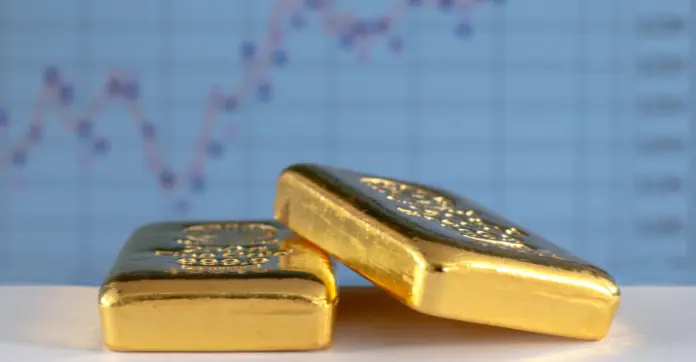Gold has stabilized around $3,747 per ounce after rebounding from recent lows near $3,717, following a healthy correction from record highs that pushed the precious metal toward $3,790 in late September, according to market analysis from XS.com.
The precious metal fell to $3,747.55 per ounce on September 26, 2025, down 0.06% from the previous day, after reaching its all-time high of $3,790.97 on September 23. The pullback primarily reflects profit-taking activity after an extended uptrend and growing investor caution as recent United States (US) economic data showed moderate strength.
Market analyst Linh Tran from XS.com attributes the correction to stronger-than-expected American economic indicators that helped strengthen the US Dollar (USD) and reduced safe-haven flows toward gold. New Home Sales reached 800,000 units, well above the 650,000 forecast and higher than the previous 664,000 reading, while second-quarter Gross Domestic Product (GDP) was revised upward to 3.8%, indicating stronger-than-expected growth.
These positive economic figures helped strengthen the dollar and cooled safe-haven flows into gold, creating near-term resistance for the precious metal despite only modest increases in Treasury yields and persistent geopolitical complexities globally.
The next critical focal point for gold investors centers on Core Personal Consumption Expenditures (PCE), the Federal Reserve’s preferred inflation gauge. This indicator could exert opposing forces on gold prices depending on the outcome and market interpretation.
If PCE data shows further easing, expectations of monetary policy relaxation would be reinforced, potentially driving real yields lower and supporting gold prices. Conversely, if inflation cools while economic growth remains solid, capital could rotate toward risk assets including equities and credit markets, reducing short-term safe-haven demand and creating deeper corrective pressure on gold.
Should PCE surprise on the upside, a hawkish repricing could push USD and real yields higher, weighing on gold performance. However, ongoing geopolitical uncertainty and strategic buying interest could limit potential downside movement.
Two key structural forces reduce gold’s sensitivity to short-term capital flows, according to the analysis. Central bank net purchases remain strategic in nature, focusing on diversifying reserves, reducing USD exposure, and hedging sanctions risk while remaining largely unaffected by market volatility.
Exchange-Traded Fund (ETF) inflows have shown signs of returning after the subdued 2022-2023 period. While not following a linear pattern, recent months have demonstrated mostly positive flows, absorbing secondary supply as derivatives markets fluctuate.
Supply-side constraints continue supporting gold’s structural outlook. Slower global mine growth, rising marginal costs, and extended investment cycles contribute to low supply elasticity, explaining why corrections often form consolidation zones rather than complete reversals when underlying demand persists.
Geopolitical tensions remain a key catalyst supporting gold demand. Unresolved conflicts in Gaza, rising tensions between NATO and Russia that increase miscalculation risks, and the possibility of renewed trade disputes during the election cycle help maintain elevated global risk premiums.
These geopolitical “hotspots” make it difficult for institutional investors to materially reduce defensive allocations, providing underlying support for gold even when macroeconomic data temporarily favors risk assets over safe havens.
Investment bank forecasts remain optimistic about gold’s medium-term prospects, with prices expected to average $3,675 per ounce by the fourth quarter of 2025 and climb toward $4,000 by mid-2026. Central bank and investor demand for gold is projected to remain strong, averaging around 710 tonnes per quarter this year.
The precious metal has demonstrated remarkable performance over the past year, with prices rising 10.29% over the past month and gaining 40.97% compared to the same period last year. This extraordinary appreciation reflects multiple supportive factors including monetary policy expectations, geopolitical risks, and strategic diversification efforts.
Despite the likelihood of short-term corrections driven by economic data surprises, gold retains a clearly positive medium-term outlook according to market analysts. Having established an impressive high near $3,790, the metal appears to be entering a rebalancing phase.
Investment strategists recommend a cautious approach in the current environment, favoring purchases during controlled pullbacks rather than chasing breakouts to manage volatility while aligning with structural drivers that continue supporting gold demand.
The combination of persistent geopolitical tensions, strategic central bank buying, returning ETF interest, and supply constraints creates a supportive foundation for gold prices despite near-term volatility related to economic data releases and monetary policy expectations.
Professional traders monitor key technical levels as gold navigates between profit-taking pressure and structural support factors. The ability to maintain levels above $3,700 could signal continued strength, while breaks below this threshold might indicate deeper corrective phases.
Market participants await upcoming economic releases including the Core PCE data to gauge the Federal Reserve’s potential policy trajectory and its impact on real yields, which directly influence gold’s attractiveness relative to interest-bearing assets.
The precious metal’s performance during this critical period will likely depend on the balance between improving US economic fundamentals and persistent global uncertainties that continue driving demand for traditional safe-haven assets among institutional and retail investors worldwide.
